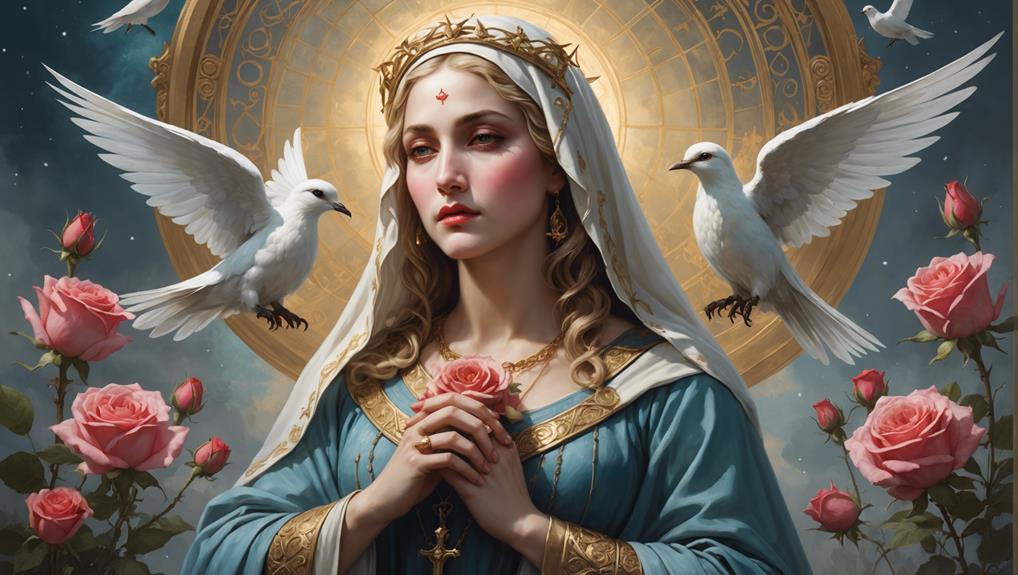Summary
- 1 Origins of representations of Madonna
- 2 Symbolism of serene expression
- 3 Meaning of the blue robes
- 4 Depiction of the Madonna and Child
- 5 Religious and cultural influences
- 6 Evolution of representations of Madonna
- 7 Contemporary Interpretations
- 8 Frequently asked questions
- 8.1 How has Madonna's portrayal influenced modern trends in fashion and art?
- 8.2 Are there hidden or little-known symbols in Madonna's artwork?
- 8.3 What are Madonna's most famous artworks around the world?
- 8.4 How do different cultures interpret the meaningfulness of Madonna?
- 8.5 Are there any controversial or contested interpretations of Madonna?
Discover the deep meanings behind representations of Our Lady. Her serene expression conveys peace, compassion and grace. The symbolic blue dress represents purity, humility and closeness to divinity. Discover the bond between Madonna and Child, embodying love, protection and faith. Examine how religious, cultural and contemporary influences shape her image. The significance of the Madonna extends beyond art, shaping values of femininity, motherhood and spirituality. Explores the evolving representations and interpretations of this iconic figure. Examination of the symbolism of the Madonna will reveal layers of depth and insight.
Origins of representations of Madonna
Investigates the origins of representations of the Madonna to discover the rich history and cultural significance behind these representations. Madonna, which means 'my lady' in Italian, refers to the representations of the Virgin Mary, the mother of Jesus. The earliest representations date back to the II century, with the oldest known image found in the Catacombs of Priscilla Rome. These representations have evolved over time, influenced by different cultures and artistic styles.
In the Byzantine era, images of Our Lady often depicted her as regal and solemn, emphasizing her role as Queen of Heaven. As art progressed in the period of the Renaissance, artists such as Leonardo da Vinci and Raphael brought a sense of grace and beauty to paintings of the Madonna, capturing her maternal love and purity.
The representations of Our Lady are not only of religious significance, but also serve as reflections of the values and ideals of society. Over the centuries, these images have become iconic symbols of motherhood, grace and divinity, crossing religious boundaries to resonate with people all over the world.
Symbolism of serene expression
The serene expression often portrayed in depictions of Our Lady conveys a sense of peace and tranquility that resonates with viewers from different cultures and historical periods. This calm and gentle look on Our Lady's face serves as a symbol of maternal love, compassion, and understanding. The serene expression invites viewers to connect emotionally with the figure of Our Lady and find comfort in her presence.
| Symbolism of Serene Expression | ||
|---|---|---|
| Symbol | Meaning | Representation |
| Serene expression | Peace and tranquility | Motherly love |
| Sweet look | Compassion | Understanding |
| Calm behavior | Grace | Emotional connection |
Our Lady's serene expression not only reflects her role as a mother, but also embodies virtues such as grace and empathy. Through her gentle gaze and peaceful demeanor, Our Lady symbolizes a source of comfort and strength for those who seek reassurance in her image.
Meaning of the blue robes

Adorned in blue robes, Our Lady's clothing has a deep symbolic meaning that goes beyond the simple choice of color. The color blue in religious art often represents qualities such as purity, humility and devotion. In the case of Our Lady, her blue robes not only symbolize her virtuous nature but also connect her to the divine.
Blue has long been associated with the heavens, making it a color linked to spirituality and closeness to God. By dressing Our Lady in blue, artists intended to convey her elevated status as the Mother of Christ. The serene and calming effect of blue also reflects Our Lady's role as a source of comfort and reassurance for believers.
In addition, the use of blue clothing highlights Our Lady's maternal qualities. Blue is often seen as a nurturing color, emphasizing Our Lady's role as a caring and compassionate figure. The choice of blue for her clothing serves to reinforce her image as a loving and protective mother to all.
Depiction of the Madonna and Child
Blue cloaks are not the only significant aspect of the depiction of the Madonna; the depiction of the Madonna and Child is another iconic and significant theme in religious art. This representation often symbolizes the bond between mother and child, conveying themes of love, purity, and protection. In many works of art, the Madonna is shown cradling the baby Jesus in her arms, emphasizing the nurturing and maternal nature of Mary.
| Symbol | Meaning |
|---|---|
| Aureola | Divine nature of Jesus |
| Apple | Original sin and redemption |
| Lily | Purity and innocence |
| Book | Wisdom and knowledge |
| Dove | Holy Spirit and peace |
Each element in the depiction has a specific importance, adding layers of depth to the artwork. The Madonna and Child theme not only celebrates the relationship between Mary and Jesus, but also serves as a powerful visual reminder of faith, love, and the divine presence in human life.
Religious and cultural influences

Let us examine the religious symbolism present in Our Lady and how it reflects the cultural significance. Understanding the intertwined nature of religious and cultural influences in the depiction of the Madonna can provide valuable insight into the deeper meanings of this iconic representation. From religious iconography to the social norms, Our Lady embodies a rich web of beliefs and values that have shaped her representation over the centuries.
Religious symbolism in the Madonna
Explores the intricate layers of religious symbolism within Our Lady, influenced by both religious and cultural traditions. Our Lady, a central figure in Christian iconography, embodies various symbols that have profound religious significance. One of the most prominent symbols is the halo that surrounds her head, representing her holiness and divine connection. This halo is a common attribute in religious art, signifying the radiant spirituality of the figure depicted.
In addition, Our Lady often holds the baby Jesus in her arms, symbolizing her role as Mother of God. This image emphasizes her purity, maternal love and the divine nature of Jesus. The motif of the Madonna and Child has roots in both Christian theology and ancient representations of mother and child deities.
In addition, Our Lady's posture and facial expressions convey messages of grace, compassion and strength. These aspects reflect the cultural values of femininity, motherhood and devotion. By examining the religious symbolism in the Madonna, a deeper understanding of the spiritual significance and cultural impact of this iconic figure can be gained.
Cultural significance of Madonna
Understanding the cultural significance of the Madonna requires delving into the intertwined influences of religious and cultural traditions. The Madonna, often depicted as the Virgin Mary holding the infant Jesus in her arms, occupies a central place in both Christian iconography and broader cultural contexts. In religious circles, she symbolizes purity, motherhood, and divine grace, embodying virtues that resonate across cultures and beliefs.
Culturally, Our Lady has inspired countless works of art, music, and literature, crossing cultural boundaries to become a universal symbol of love and compassion. From Renaissance masterpieces to modern pop culture references, her image has been reinvented and reinterpreted in different ways. Our Lady's influence extends beyond the art world, shaping social norms and perceptions of femininity, motherhood and spirituality.
Evolution of representations of Madonna
Let's talk about how representations of Madonna have evolved over time. From iconic image to cultural influences, Madonna's representations have continually changed to reflect the changing social norms and values. Understanding this evolution can provide insight into Madonna's enduring importance in art and culture.
Iconic images of Madonna
Examine the evolution of Madonna's representations through iconic images that have shaped her cultural relevance over the years. Madonna's image has undergone a remarkable transformation, from her early days in the 1980s with lace gloves and a rebellious attitude to her more recent reinventions as a sophisticated and politically engaged figure. One of Madonna's most iconic images is from the 'Like a Virgin' era, with her stacked crucifixes and tulle skirts defying social norms. As Madonna continued to push boundaries, her 'Blonde Ambition' phase brought us the famous cone bra and a strong sense of empowerment. As we enter the 21st century, Madonna's imagery has evolved once again, with her 'Material Girl' persona giving way to a more mature and introspective aesthetic. The evolution of Madonna's representations through these iconic images shows her ability to adapt, provoke and inspire, solidifying her status as a cultural icon for future generations.
Cultural influence of Madonna
Madonna's cultural influence has continually evolved through her changing representations in iconic images, reflecting her ability to adapt, provoke and inspire across generations. From her early days defying social norms with hits like 'Like a Virgin' to her later reinventions as a provocateur in works like 'Erotica' and a spiritual figure in songs like 'Like a Prayer,' Madonna has consistently pushed boundaries and redefined pop culture.
Her impact goes beyond music, extending to fashion, film, and even activism. Madonna's fearless approach to self-expression has inspired countless artists and individuals to accept their uniqueness unconditionally. Through her various personalities, she has demonstrated that it is not only acceptable, but also rewarding, to continually evolve and challenge conventional expectations.
While Madonna's image has changed over the years, her influence remains a tribute to the enduring power of self-reliance and reinvention. Whether she wears a wedding dress or a cone bra, Madonna's ability to engage audiences and start cultural conversations endures, solidifying her iconic status for the ages.
The evolving representations of Madonna
As Madonna's career has progressed, her representations in evolving iconic images have shown a dynamic and ever-evolving person who continues to captivate audiences worldwide. From her early days as a rebellious pop princess to her transformation into a boundary-defying pioneer, Madonna's changing portrayals have always pushed the boundaries of art and self-expression.
- Fashion Chameleon: Madonna's style has steadily evolved, from lace and leather in the 1980s to glamorous dresses in the 1990s and bold street wear in the 2000s.
- Queen of Reinvention: Madonna's ability to constantly reinvent herself has kept her relevant for decades, inspiring fans to embrace change and growth.
- Iconic Visual Narrative: Through music videos, performances, and photo shoots, Madonna has used visual imagery to convey powerful messages about empowerment, sexuality, and individuality.
Each new era in Madonna's career brings with it a new interpretation of her persona, solidifying her status as a cultural icon and pioneer in the world of music and fashion.
Contemporary Interpretations

In modern times, people often interpret Our Lady as a symbol of strength and resilience in the face of adversity. This interpretation has gained prominence as individuals seek inspiration from historical figures who embody perseverance and grace in difficult circumstances.
To explore how Our Lady is perceived today, let us dive into a comparison of different contemporary interpretations:
| Interpretation | Description |
|---|---|
| Symbol of Power | It represents power and liberation for women. |
| Icon of Hope | Seen as a guiding light of hope and comfort in difficult times. |
| Supporter of Equality | Strives for equality and social justice for all. |
These interpretations reflect the evolving significance of Our Lady in modern society, where her image continues to resonate with individuals facing adversity and working toward a better world. Our Lady remains a timeless symbol of strength and resilience, inspiring many to overcome challenges with grace and determination.
Frequently asked questions
How has Madonna's portrayal influenced modern trends in fashion and art?
Madonna's interpretation has been a fulcrum in shaping modern fashion and art trends. Her bold and innovative style has inspired countless designers and artists. From her iconic cone bras to her boundary-pushing music videos, Madonna's influence is undeniable. Her fearless approach to self-expression continues to resonate in the creative industries today. By defying norms and embracing individuality, Madonna has left an indelible imprint on the fashion and art worlds.
Are there hidden or little-known symbols in Madonna's artwork?
Discovering symbols can be found in Madonna's artwork. From subtle religious references to personal motifs, her pieces often encapsulate deeper meanings. As you delve deeper into her work, you may discover lesser-known symbols that add layers to the narrative. Be alert to details that offer insight into Madonna's thoughts and inspirations. Investigating these hidden symbols can provide a richer understanding of her art and the messages she conveys through her work.
What are Madonna's most famous artworks around the world?
Regarding Madonna's most famous artworks around the world, there are some true masterpieces that have captured the hearts of many. From the iconic 'Our Lady of the Rocks' by Leonardo da Vinci at the breathtaking 'Madonna and Child' by Raphael, these masterpieces continue to inspire and amaze people of all generations. The intricate details and deep symbolism in these works make them true timeless treasures In the art world.
How do different cultures interpret the meaningfulness of Madonna?
Different cultures interpret the meaning of Madonna in different ways. Some see her as a symbol of motherhood and purity, while others see her as a representation of divine femininity and strength. How people perceive Madonna often reflects their unique cultural beliefs and values. By delving into these interpretations, it is possible to gain a deeper understanding of how different cultures connect with this iconic figure.
Are there any controversial or contested interpretations of Madonna?
When exploring interpretations of Our Lady, controversies may arise due to different cultural, religious and personal beliefs. Some controversial views may challenge traditional interpretations, sparking debates about symbolism, representation, and social norms. It is crucial to approach these contested interpretations with an open mind, recognizing that different perspectives contribute to a deeper understanding of Our Lady's meaning in different cultures and contexts.
